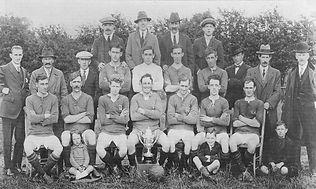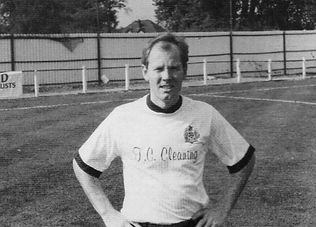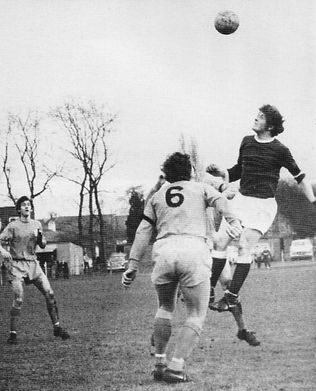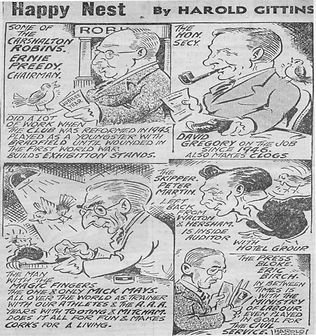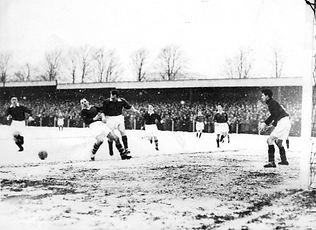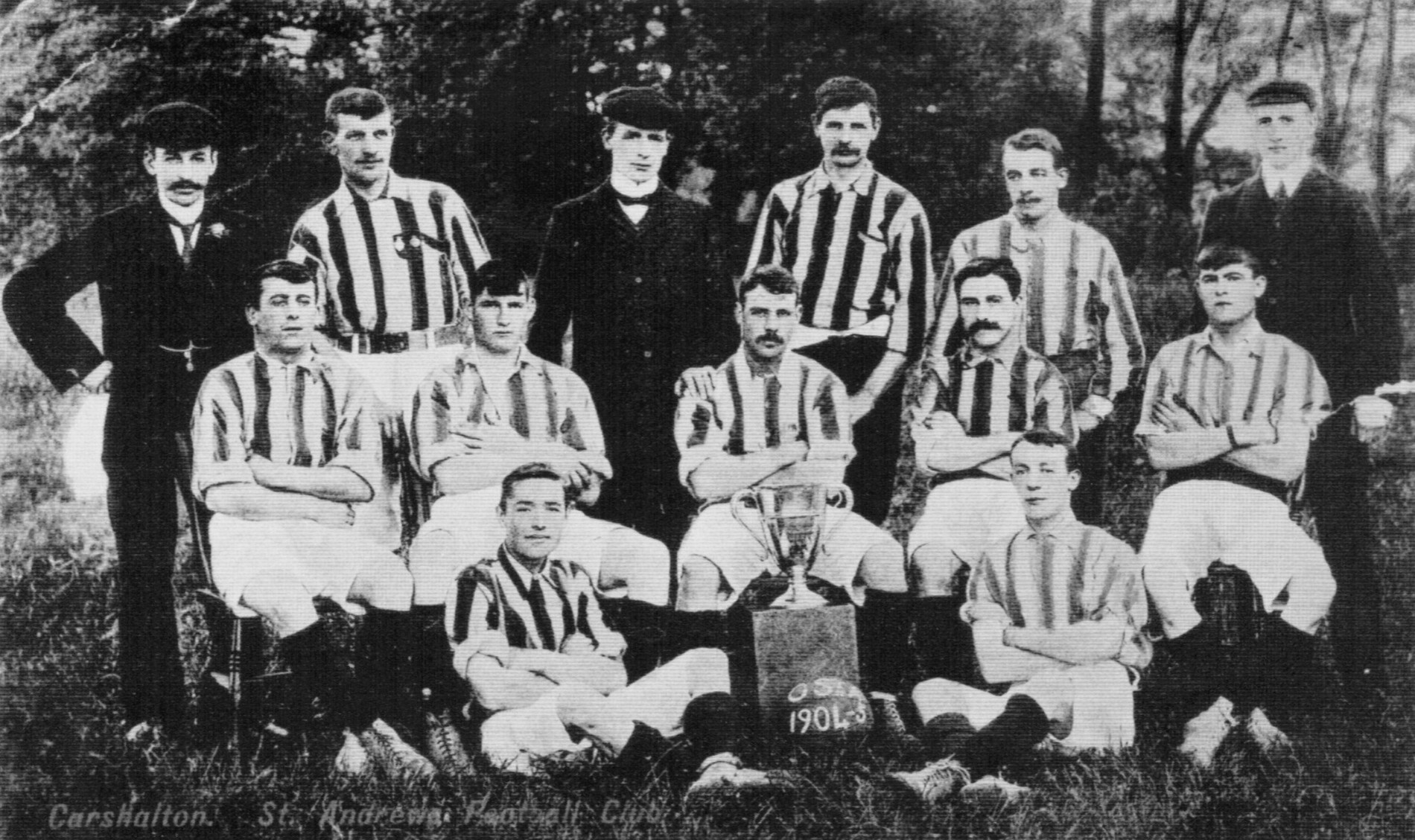1903 onwards …in too few words
The early years
Carshalton Athletic traces its roots to two separate teams playing in the area of Wrythe Green in Carshalton in the early twentieth century. Whilst the club’s history is dated to the formation of Mill Lane Mission in 1905 it also recognises the importance of officials, players and supporters of Carshalton St Andrews in its history.
Mill Lane Mission was organised by the Mill Lane Mission recreational facility for teenage boys and began playing friendlies in 1903. They were formally registered with the Surrey County FA in September 1905 and continued to play only friendly matches until 1906 when they joined the Croydon & District League Division 2A. During 1905 and 1906 discussions were held with Carshalton St Andrews over amalgamation.
Carshalton St Andrews was formed in 1897 by the vicar of St Andrews, Revd. C.W. Cleaver and began playing in the Surrey County Herald League. In 1902 they were promoted into the Southern Suburban League Division 2 West. They agreed to fold and amalgamate with Mill Lane Mission in 1906 but did not formally do so until they had honoured their remaining obligations at the end of the 1907–08 season.
Meanwhile, Mill Lane Mission registered their name change with the Surrey F.A. and began playing under the name Carshalton Athletic F.C. in 1907. The first ever match under this name was on 7 September 1907 at home on the Wrythe Green recreation ground in a friendly against Westbrook (Thornton Heath).
Carshalton Athletic’s first colours were red with white stripes – adopted from St Andrews from whom the Robins were formed when they merged with Mill Lane Mission.
After the name change the club went on to win successive promotions in 1908, 1909 and 1910 which were rewarded with election to the Junior Division of the Southern Suburban League. During this time the club put out a reserve side and a midweek Carshalton Wednesday side (many different clubs set up these sides to play after the shops had shut ‘early’ on Wednesdays) and these two sides both performed well – the reserves winning the Croydon and District League Division 2A in 1909 and Carshalton Wednesday were runners up in the inaugural Surrey County Midweek Cup.
Before the outbreak of the First World War further success in both league and junior cup competitions was achieved. In 1913 the club won the Suburban League Division 1 West and the following season added the Suburban League Division 1 East title to this. In the same period they also won the Surrey Junior Cup, Surrey Junior Charity Cup and the Croydon Charity Cup and were runners up in the London Junior Cup. The outbreak of the war curtailed this period of success and the club went into a period of suspended animation during the war as its home ground was given over to agricultural use.
Following the reformation of the club on 31 March 1919, and after playing on a number of different grounds, Carshalton Athletic finally moved into their new (and current) home in Colston Avenue during the 1920–21 season. This was built as a memorial to those members of the club who lost their lives in the War.
The inter-war years were otherwise relatively uneventful. The only silverware the club won was the Surrey Intermediate Cup, in 1922 and 1932. In the league, the club remained in the Southern Suburban League, finishing as runners up in 1922 before becoming founding members of the Surrey Senior League in the 1922–23 season. At the same time the club gained Football Association senior club status and this allowed Carshalton Athletic to enter FA national competitions and county senior cups for the first time.
Post-war and the Corinthian League
With the upheavals of the Second World War in Europe over, preparations for the resumption in football at Colston Avenue began 1945 with applications made to join the London League (senior side) Surrey Intermediate League (reserve side) and to enter the London Senior and Surrey Senior cups.
The club did not apply to enter the FA Challenge Cup or FA Amateur Cup because facilities at the ground were not up to standard for these competitions. The club did make it a priority to improve the standard of the ground and facilities to make them suitable for the higher reaches of the amateur game but all this work had to be funded and carried out by volunteers as the local District Council were unwilling to help support these improvements. Fortunately it proved possible to find volunteers and donors to enable this work to be carried out. The work on the ground proved to be needed the following season as Carshalton Athletic were elected into the Corinthian League, which had been set up in the previous year, for the 1946–47 season.
Several years of indifferent league form followed with only minor highlights in cup competitions, although the club continued to grow as evidenced by a record attendance of over 8000 for an FA Challenge Cup 3rd round qualifying tie against local rivals Tooting and Mitcham United. Behind the scenes the club was taking steps to improve the club’s chances on the pitch including hiring a coach for all sides for the first time but the club committee ensured that they retained the final say in selection decisions.
A far better period began with the first match Carshalton Athletic played against a team from overseas at the start of the 1952–53 season. Hengelo from the Netherlands were the opponents in what was to become a regular friendly fixture over following years. Carshalton went on to win the Corinthian League title by 3 points from Hounslow Town at the end of the season and the reserve team finished second in their league, 2 points behind Uxbridge. The 1953–54 season brought further success as Carshalton Athletic retain the league title, finishing 2 points ahead of Edgware Town, although cup success was still proving elusive. This was rectified somewhat in the 1954–55 season as the club reached the final of the Surrey Senior Shield and the quarter finals of the FA Amateur Cup for the first time in their history (this was also the first year in which two Corinthian League teams reached the quarter finals). The 1955–56 season was unremarkable on the pitch but did see further advances around the ground as Carshalton Athletic’s success of recent season was reflected in the size of the supporters club with over 2000 members. It was also the club’s last appearance in the Corinthian League as the summer of 1956 saw election to the Athenian League.
Athenian League
For the next 17 years the club competed in the Athenian League with very little success never really threatening to win the league, and finishing at the bottom of the table twice (1959–60 and 1960–61 seasons). Their best performance coming in the 1963–64 season when the club managed to finish the season in third place. Around the ground floodlights were finally erected on six pylons in 1967.
Limited cup success was achieved. A first appearance in the Surrey Senior Cup final came in the 1957–58 season, although Dulwich Hamlet won the final 1–0 and it would be another 31 years before Carshalton Athletic appeared in the final again. There was also success in the FA Amateur Cup as the club reached the quarter finals for the second time in 1959–60. In the same season the club won the Southern Combination Cup for the first time, after losing in the final the previous season.
Isthmian League 1973–2004
In the summer of 1973 Carshalton Athletic finally achieved a promotion of sorts when they were elected as founder members of the newly created Isthmian League Division 2. The first two seasons proved to be a struggle and in their third they just missed out on promotion finishing third in the league. Three years of struggle paid off in the 1976–77 season when promotion to the Isthmian Premier Division after finishing as runners up in the league in a year in which they also won the Surrey Senior Shield.
After promotion in the league the club entered another period of struggling, not finishing in the top half until the 1987–88 season. This coincided with the start of years of upheaval in the organisation of the ownership and running of the club both on and off the field. The best that could be offered to supporters in this period was a solitary cup run as the club reached the second round proper of the FA Challenge Cup for the first time before losing 4–1 to Fourth Division Torquay United. Over this period Carshalton Athletic had 8 different managers and it was only the final appointment of Billy Smith in August 1986 that began to turn the club’s fortunes around.
The first Billy Smith era lasted for nearly 9 years and was the most successful period in the club’s history. During his time in charge of the club twice reaching the 1st Round Proper of the FA Challenge Cup, winning the Surrey Senior Cup three times in four years and reaching the final 5 times in 7 years, recording its highest ever placing in the league at the end of the 1988–89 season and winning the London Challenge Cup in 1991. This period came to an end when Billy Smith left to take charge of Kingstonian, and was followed by a rapid turnover of managers.
Under John Rains, the club reached the third round of the FA Trophy. Gary Kilby led them to the first round proper of the 1997–98 FA Cup, in which they lost to Stevenage Borough after a replay, and former player Gary Bowyer twice led a successful fight against relegation. In 2000, with the club in severe financial difficulties, the ownership changed hands twice, Bowyer was dismissed, the clubhouse was destroyed in an arson attack, and the ground’s landlords, Sutton Council, threatened the club with eviction for breaching their lease.[1][2] At the end of that season, Carshalton were relegated to Division One. Two years later, Graham Roberts led them to the Division One South title, to gain promotion to the Premier Division. The following season, they finished seventh, thus qualifying for the new Conference South.
Conference South
After a £12 million plan to rebuild the ground fell through,[3] chairman Steve Friend resigned, followed by manager Billy Smith. Under Jimmy Bolton, Carshalton retained their place in the Conference South in 2004–05.
In 2005–06, the club’s centenary season, the Club was relegated back to the Isthmian League.
Isthmian League 2008–onwards
The new millennium did little to help the club’s financial problems. Like many clubs at the time Carshalton Athletic found it difficult to pay its bills and was severely overstretched by a hefty playing budget.
The previous season’s relegation was a blow, but the Club was not new to hard times – over the previous two decades the club had been on the edge of bankruptcy numerous times, seeing five different owners and a long line of chairmen. In 2008 the club was technically insolvent. Despite having some sucess in stabilising Carshalton Athletic, the then current owners could not see a way through its financial difficulties without change, there were large tax bills that the club could not pay.
Local businessman Paul Dipre purchased the club in 2008, paid off substantial tax bills and set out a ten year plan to develop the club into a community hub. Dipre promised to rejuvenate the club from the bottom up.
Carshalton finished mid table in 2006–07 but the following season 2007–08 saw disappointing early results and as a result the manager Dave Garland left the club in October 2007. The appointment of Hayden Bird was one of the last acts of the previous owners.
Hayden made some high profile signings and there was a noticeable commitment to playing attractive, passing football but the Robins still faced another nail-biting fight for survival in the Isthmian League Premier Division. Paul Dipre injected sufficient funds to strengthen the squad in an effort to avoid relegation. It went right to the wire and, miraculously, last day results elsewhere fell perfectly and Carshalton’s home win over Tonbridge Angels was enough to secure their status.
The season 2008–09 was the first full season under new ownership. The reserves and junior sections were axed in favour of a new academy and junior section. The club began a long-term investment program to renew its crumbling facilities. Directors and staff were axed in favour of a new management team.
The first year under Dipre was one of the club’s most successful. On the pitch, aided with 31 goals from Richard Jolly, The Robins finished in 4th place, setting up a play-off semi-final with Tonbridge Angels. Athletic claimed a thrilling 3-2 win to meet Staines Town in the final. Held at Staines’s Wheatsheaf Park Ground, Carshalton more than held their own against Staines, who had finished 2nd in the regular season. Sadly for The Robins, an 85th-minute penalty was saved by Staines ‘keeper Louis Wells, and Scott Taylor scored an extra-time winner for Staines.
At the end of this season the club decided to revert to its original colours of Red and also modernised its badge. The change was supported by the majority of fans who saw the colour change as one that reflected the club’s early heritage, but a small group of fans (largely led by the club officials ousted by Dipre) lobbied against the change strongly.
On 1 September 2009, manager Hayden Bird resigned as the club’s first team manager; Ian Hazel was placed in caretaker charge. On 10 September the club announced the appointment of former Carshalton player Francis Vines as Bird’s permanent replacement.
Shortly before the 2010–11 season Mark Butler was placed in charge of the club. After a promising first half of the season, Butlers results went from bad to worse until finally the owner Paul Dipre too the reins. The team finished 13th.
The 2011–12 season was a rollercoaster for the first team. Dipre’s first season as manager ended in 16th position. Despite the inconsistent league form there was much to celebrate in the FA Trophy with one of the most Historic results in the club’s history when they beat Lincoln City 3–1 at Colston Avenue, Paul Vines scoring a hat-trick. Before the beginning of the following season Dipre resigned from the manager’s position and coach Tommy Williams, also a former player of the club, took the reins and officially took the job in October 2012.
Carshalton Athletic was bestowed with three community club awards throughout 2012 – the South East Regional Community Club of the Year, the Surrey FA Community Club of the Year and the FA National Community Club of the Year, the latter awarded to (the then) club chairman Frank Thompson, youth development officer Paul Williams and club director Kelly Anscombe by ex-professional footballers Chris Kamara and Martin Keown, plus TV presenter Ben Shepherd.
In the following year the club won the UEFA silver award for the best grassroots club in Europe, one of the greatest accolades in the club’s history.
In Tommy Williams first season as manager, Carshalton finished 21st in the Isthmian Premier in 2012-13, which ordinarily would have seen them relegated. However, a points deduction and consequent relegation for Thurrock gave them a reprieve, keeping them in the Isthmian Premier for the 2013-14 season.
In the following season Carshalton Athletic were relegated to the Ryman South under Stuart Massey.
The 3G
In 2015 the club decided to apply for planning permission to install a 3G pitch. The application was supported by almost everyone at Carshalton Athletic. The 3G was intended to provide facilities for the 500 or so junior players and other local clubs. It would secure the club’s future. The club applied for planning. The original planning application was recommended by the council for approval, but rejected by councillors in January 2014. The club appealed, and won in January 2015.
The 3g was installed in the Summer of 2015. The entire Ground was also refurbished between May 2016 – August 2017. Colston Avenue has become a busy sports and community hub seven days a week serving teams, clubs and community organisations.
2015/6
The 2015/16 was a reasonable year for the first team finishing a respectable 10th place in Ryman South. Managers Matt Howard and Chris McGinn each had good spells on the pitch. Fans favourite Tommy Bradford won the players of the year award with 24 goals and performances improved as the season went on. By the end of the season and following a number of unsuccessful appointments over recent years, the club decided on a new approach to the 1st team management structure. That new structure was implemented in April 2016 when Peter Adeniyi, Ted Dale and Mike Gilham were appointed as Manager, Head Coach and Coach respectively.
2016/17
Peter Adeniyi’s first season was a good one. Peter further improved the teams style of play and pushed the youth policy with renewed vigour. Ex- player Stuart Searle joined Peter’s team as coach in replacement of Mike Gilham who had moved into an Academy role at Fulham. The club was in the playoff places for much of the season but not at the time when it counted and finished one place short of a valuable playoff position. Nevertheless The Robins had made clear their ambitions on the pitch and Peter Adeniyi agreed to stay on for the season 2017/18.
2017/18
Peter Adeniyi’s second season started with some important new signings. Billy Bishop took the number 1 shirt, Raheem Sterling Parker joined from Chipstead and Jordan Cheadle from Walton casuals. At Christmas Keith Boanas joined the Robins in the role of head Coach. In January, academy graduate and Top goalscorer Mickel Miller transferred to Scottish Premiership side Hamilton Academical for an undisclosed fee.
The Robins won the Isthmian South League and were promoted to the Isthmian Premier.
2018/19
The Robins made a comfortable start in the Isthmian Premier league. There were very few team changes from the previous season, but one important signing was that of Harry Ottaway, who joined in January 2019.
The team enjoyed a long winning run in the second half of the season to finish runners up in the Isthmian Premier league, but lost their first playoff game against Merstham FC.
In 2019 the club launched its Football Academy Programme – a combined education and football development programme for 16-18 year olds.
2019/20
The 2019/20 season Club Chairman Paul Dipre announced the clubs ambitions to reach the National League by 2025. “The last ten years have put the club is in a very good place organisationally, financially and structurally, its time to push on with our first team ambitions”
Unfortunately, in March 2020, with Carshalton comfortably placed in the playoff positions, the league was curtailed by the COVID pandemic.
2020/21
After the disappointment of the previous season’s curtailment due to COVID, First Team manager Peter Adeniyi once again was set the task of promotion. However, COVID was to ruin the teams success on the pitch once again. For the second year in succession, with Carshalton comfortably seated in the playoff positions, the league season was terminated by the COVID pandemic.
2021/22
The 2021/22 season started well, but a steady decline from Xmas onwards saw the Robins finish in its lowest position during Peter Adeniyi’s reign. At the end of the season Peter Adeniyi stepped down as first team manager to take up a position as the director of football. Carshalton Athletic remained at Peter Adenitis main employment and he continued to work at the club 5 days a week
2022/23
The vacant manager’s position was advertised soon after the end of the 2021/22 season. It took nearly a month of interviews and re-interviews with many well qualified applicants before the new first team manager was chosen. Steve McKimm ex-Tonbridge Angels Manager was given the job. McKimm brought in his coaching team and bench staff and set about the task. There was some success but overall the season was not what was hoped for. Steve McKimm was relieved of his position at the end of the season.
2023/24
Club Chairman, Paul Dipre invited Peter Adeniyi to return to the position as manager which was accepted.




